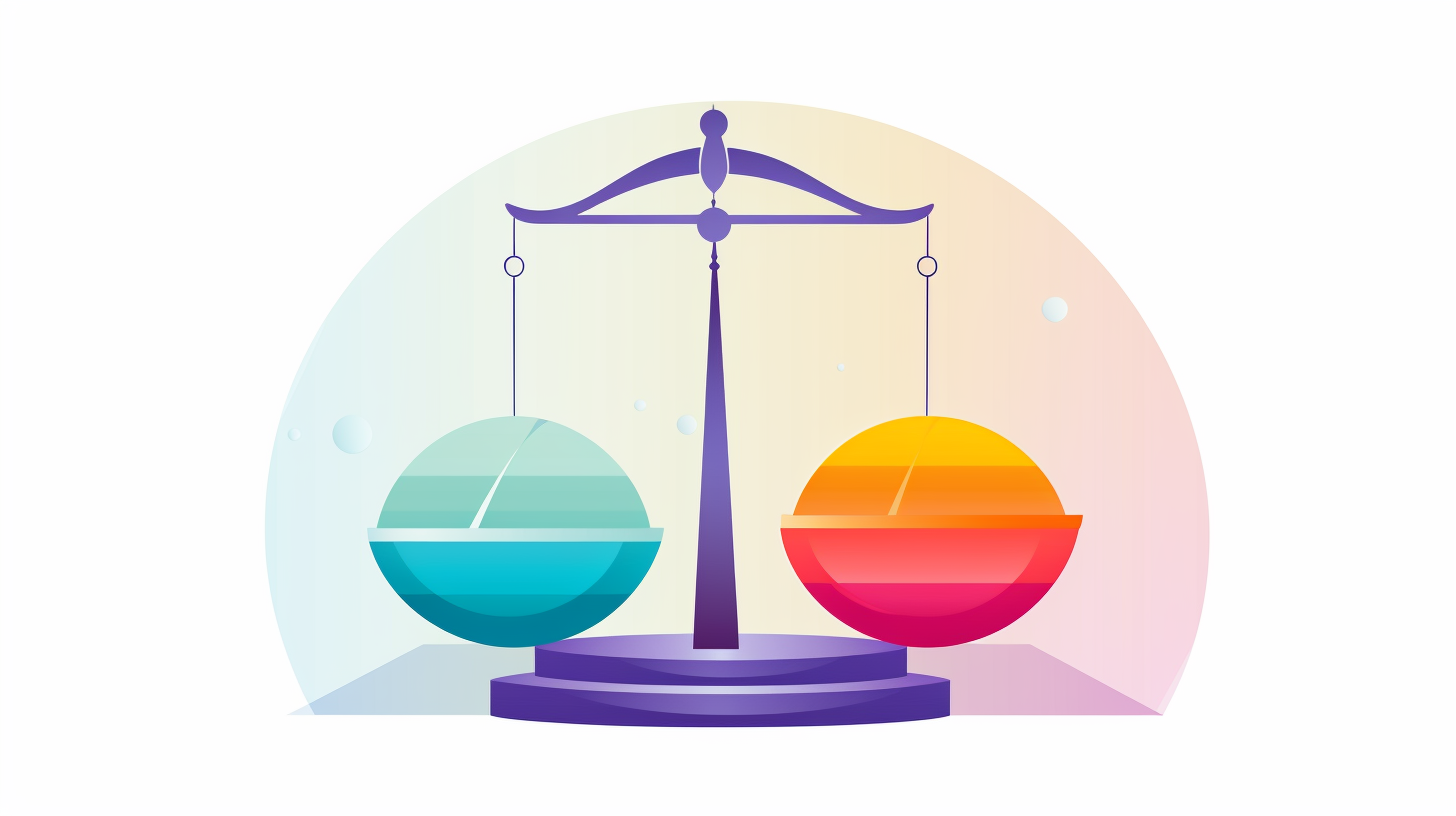Differences Between Good Debt and Bad Debt Explained

As a professional copywriting journalist, I understand that understanding debt can be overwhelming and confusing. Debts can be classified into good or bad, and knowing the difference can have a significant impact on your financial well-being. In this article, I will provide an overview of good debt and bad debt, explaining the key differences between the two concepts.
Key Takeaways
- There are two main categories of debts: good debt and bad debt.
- Knowing the difference between good debt and bad debt is crucial to your financial success.
- This article will explore the definition, benefits, and consequences of good debt and bad debt, as well as provide strategies for managing and avoiding debt.
Defining Good Debt and Its Benefits

When it comes to managing debt, it’s important to understand the difference between good debt and bad debt. Good debt is an investment that helps you build financial stability and wealth over time. It’s typically considered an investment because it generates a return on your investment.
Good debt can take many forms, such as student loans, business loans, or a mortgage. These debts are investments in your future and can lead to a higher earning potential. For example, taking out a student loan to pay for college can lead to higher-paying job opportunities in the future.
One of the key benefits of good debt is that it can help improve your credit score. When you make regular payments on time, it shows lenders that you are a responsible borrower. This can make it easier to get approved for future loans and credit cards, and at better interest rates.
Managing good debt involves creating and sticking to a debt payment plan, setting realistic goals, and avoiding taking on too much debt at once. Some debt management tips for good debt include:
- Create a budget and stick to it.
- Make payments on time and in full.
- Pay more than the minimum payment when possible.
- Consider consolidating debt to make payments more manageable.
Overall, good debt is an important tool for building wealth and financial stability. By understanding the different types of debt and how to manage them effectively, you can make smart financial decisions and achieve your financial goals.
Understanding Bad Debt and Its Consequences

While good debt can be a valuable tool, bad debt can have serious consequences for your financial health. Unlike good debt, which is used to purchase assets that appreciate in value, bad debt is used to buy things that quickly lose value or have no value at all. Examples of bad debt include high-interest credit card debt, payday loans, and car loans with unfavorable terms.
One of the biggest consequences of bad debt is the high interest rates that come with it. These rates can quickly add up, making it difficult to pay off the debt and causing it to linger for years. Furthermore, bad debt can negatively impact your credit score, making it harder to obtain loans and credit in the future. This can affect your ability to purchase a home, car, or other assets.
It’s important to understand the different types of bad debt and how to avoid them. For example, credit card debt can quickly become bad debt if you only make minimum payments or consistently carry a balance. One way to manage and ultimately eliminate bad debt is to create a debt repayment plan. This plan should prioritize paying off high-interest debt first and making extra payments towards the debt whenever possible.
By understanding the differences between good debt and bad debt and taking proactive steps to manage your debt, you can avoid the negative consequences of bad debt and work towards a more secure financial future.
The Impact of Good Debt on Credit Score
Understanding the impact of good debt on your credit score is crucial for maintaining a healthy financial status. Good debt, such as a mortgage or a student loan, can positively impact your credit score when you make timely payments and pay off the debt in full. This is because lenders view good debt as an investment in your future financial stability and are more likely to approve future credit applications.
Additionally, good debt can improve your credit utilization ratio, which is calculated by dividing your total credit balances by your total available credit. A lower credit utilization ratio is better for your credit score, and having a mix of different types of credit, including good debt, can also improve your score.
However, it’s important to note that taking on too much good debt can also have negative consequences for your credit score and financial health. It’s essential to borrow only what you can afford to repay and to use good debt strategically to achieve your financial goals.
To make sure you’re utilizing good debt properly, consider implementing these debt management tips:
- Create a budget to track your monthly expenses and income
- Limit your borrowing to what you can comfortably afford to repay
- Make timely payments and pay off the debt in full whenever possible
By following these tips, you can effectively use good debt to boost your credit score and achieve financial stability.
Understanding Bad Debt and Its Consequences
In contrast to good debt, bad debt is any debt that doesn’t help you reach your financial goals and can put your financial future at risk. Bad debt usually comes in the form of high interest rates, like credit card balances that you can’t pay off each month or payday loans.
It’s important to note that not all debt is created equal, and failing to distinguish between good and bad debt can have serious consequences. Unlike good debt, which can help you build wealth and improve your credit score, bad debt can wreak havoc on your finances and can lead to long-term financial distress.
Understanding the differences between good debt vs bad debt can help you make better financial decisions and avoid taking on debt that can harm your financial wellbeing. Some key indicators of bad debt include:
- High-interest rates
- No clear benefit or return on investment
- No plan for repayment or debt management
Bad debt can have serious consequences for your financial health, including:
- Damaged credit score
- Collection calls and legal action
- Difficulty qualifying for loans or credit in the future
- Inability to save for long-term goals, like retirement or a down payment on a house
To avoid falling into the trap of bad debt, it’s important to have a solid understanding of your financial situation and only borrow money when you know you can pay it back. This might mean avoiding high-interest credit cards, establishing an emergency fund, and seeking out financial advice when needed.
Exploring Debt Repayment Strategies
Managing debt can be challenging, but with the right strategies, it’s possible to pay off your debts and regain financial stability. Here are some debt repayment strategies that can help:
1. Prioritize High-Interest Debts
| Debt Type | Interest Rate |
|---|---|
| Credit Card Debt | 18% |
| Student Loans | 6% |
| Mortgage | 3.5% |
If you have multiple debts, prioritize paying off the ones with the highest interest rates first. This will reduce the amount of interest you’ll need to pay over time and help you become debt-free faster.
2. Create a Budget

Creating a budget is an essential part of managing debt. Start by listing all your income sources and expenses. Then, allocate a portion of your income towards paying off your debts each month. Stick to your budget to avoid overspending and accumulate savings.
3. Consider Debt Consolidation
If you’re struggling to keep up with multiple debt payments, debt consolidation might be a good option. This involves combining all your debts into one loan with a lower interest rate. Consider consulting a financial advisor to determine if debt consolidation is right for you.
4. Negotiate with Your Creditors
It’s possible to negotiate with your creditors to reduce your interest rates or work out a payment plan that suits your budget. Be proactive and contact your creditors to discuss your options.
5. Find Ways to Increase Your Income
Increasing your income is an effective way to accelerate your debt repayment. Consider getting a part-time job, selling unused items, or starting a side hustle to earn extra money.
6. Take Advantage of Balance Transfer Offers
If you have credit card debt, consider taking advantage of balance transfer offers to move your balance to a card with a lower interest rate. This can help you save money on interest and pay off your debt faster.
Implementing these debt repayment strategies can help you regain control of your finances and achieve financial freedom. Remember, managing debt takes time and effort, but with persistence, you can become debt-free.
The Role of Debt Consolidation
When it comes to managing debt, debt consolidation is a popular option for those who are struggling with multiple debts and high interest rates. Debt consolidation involves combining several debts into one payment with a lower interest rate, making it easier to manage and pay off over time.
Debt consolidation can take various forms, including balance transfer credit cards, personal loans, home equity loans, and debt management plans. Each option has its own advantages and disadvantages, so it’s important to carefully consider which one is right for your specific financial situation.
One of the benefits of debt consolidation is the potential to reduce the total amount of interest paid over the life of the debt. By consolidating high-interest debts into a single lower-interest payment, you can save money on interest charges and pay off your debts faster.
| Advantages of Debt Consolidation | Disadvantages of Debt Consolidation |
|---|---|
| Lower interest rates | Potential for additional fees and costs |
| Simplified debt management | May require collateral |
| Reduced stress and anxiety | May extend repayment term |
When considering debt consolidation, it’s important to weigh the advantages and disadvantages and understand all associated costs and fees. Make sure to read the fine print and ask questions to fully understand the terms and conditions of any debt consolidation option.
If you’re struggling with debt, debt consolidation is just one of several debt relief options available. Other options include debt settlement, debt management plans, and bankruptcy. It’s important to evaluate all options and choose the one that best fits your financial situation.
Debt consolidation can provide relief from overwhelming debt and simplify your financial management.
Customizing Debt Management Strategies
When it comes to managing debt, a one-size-fits-all approach simply doesn’t work. Each person’s financial situation is unique, and debt management strategies need to be customized accordingly. While there are general tips and guidelines that apply to everyone, it’s essential to create a personalized plan based on your specific circumstances.
The first step in customizing your debt management plan is understanding your current financial situation. This involves taking a close look at your income, expenses, and debts. You need to know exactly how much you owe, what your interest rates are, and what your monthly payments are.
Once you have a clear understanding of your financial standing, you can start exploring different debt management strategies that will work for you. For example, if you have multiple high-interest credit card debts, you may want to consider consolidating them into a single lower-interest loan. Or, if you’re struggling to keep up with your payments, you may need to prioritize your debts and focus on paying off the ones with the highest interest rates first.
One important aspect of customizing your debt management plan is setting realistic goals and expectations. For some people, becoming debt-free may not be a realistic goal in the short-term. In these cases, it’s essential to focus on making progress and taking steps to improve your financial situation gradually. Setting achievable milestones and celebrating your successes, no matter how small, can help keep you motivated and on track.
Another key component of customizing your debt management plan is seeking professional help when necessary. If you’re struggling to manage your debts and find yourself falling further behind each month, it may be time to consider working with a credit counselor or debt management company. These professionals can help you create a personalized plan and provide ongoing support and guidance as you work to regain financial stability.
Ultimately, the key to effective debt management is to be proactive, stay organized, and remain committed to your goals. By customizing your debt management plan to fit your unique financial situation and needs, you can take control of your debts and achieve long-term financial success.
The Role of Understanding Good and Bad Debt for Financial Success

Understanding the differences between good debt and bad debt is crucial for financial success. Good debt, such as a mortgage or student loan, is an investment in your future and can lead to long-term financial benefits. On the other hand, bad debt, such as high-interest credit card debt, can quickly spiral out of control and lead to financial ruin.
By recognizing the differences between the two types of debt, you can make informed decisions about your finances and take control of your debt. It’s important to remember that not all debt is created equal, and taking on debt should always be a carefully considered decision.
Creating a Personalized Debt Management Plan
To maximize the benefits of good debt and minimize the negative impact of bad debt, it’s essential to create a personalized debt management plan. This plan should take into account your income, expenses, and long-term financial goals.
Effective debt management strategies can include creating a budget, prioritizing debt repayment, and exploring debt consolidation options. By creating a customized plan, you can take control of your debt and work towards financial freedom.
The Importance of Building and Maintaining Good Credit
In addition to managing your debt, building and maintaining good credit is essential for financial success. Good credit can unlock a world of opportunities, such as lower interest rates on loans and credit cards, better rental options, and even job opportunities.
Good debt can play a significant role in building and maintaining good credit. By making timely payments on your debts and maintaining a healthy credit utilization rate, you can establish a positive credit history and improve your credit score over time.
Conclusion
Understanding the differences between good debt and bad debt is essential for financial success. By taking control of your debt through customized debt management strategies and building and maintaining good credit, you can achieve your long-term financial goals.
Remember, debt can be a useful tool when used wisely, but it can also be a financial burden when mismanaged. By staying informed and making informed decisions about your finances, you can take control of your debt and achieve financial freedom.
FAQ
Q: What is good debt?
A: Good debt refers to borrowing money for investments or assets that have the potential to increase in value or generate income over time. Examples of good debt include student loans, mortgages, and business loans.
Q: What is bad debt?
A: Bad debt refers to borrowing money for expenses that do not provide any long-term benefits and may not generate income. This includes credit card debt used for luxury items or unnecessary purchases.
Q: What are the benefits of good debt?
A: Good debt can help you build credit, increase your net worth, and provide opportunities for financial growth. It can also help you achieve important goals, such as homeownership or starting a business.
Q: What are the consequences of bad debt?
A: Bad debt can lead to financial stress, high-interest payments, and damage to your credit score. It can restrict your ability to get approved for future loans or credit cards and hinder your overall financial health.
Q: How does good debt impact your credit score?
A: Good debt, when managed responsibly, can have a positive impact on your credit score. It shows lenders that you are capable of borrowing and repaying money responsibly, which can improve your creditworthiness.
Q: What are some debt repayment strategies?
A: Some debt repayment strategies include the snowball method, where you pay off your smallest debts first, and the avalanche method, where you prioritize debts with the highest interest rates. Other strategies include budgeting, negotiating lower interest rates, and seeking professional debt counseling.
Q: What is debt consolidation?
A: Debt consolidation is the process of combining multiple debts into a single loan or repayment plan. This can simplify your finances by consolidating multiple payments into one and potentially lower your interest rate or monthly payment.
Q: Why is customizing debt management strategies important?
A: Customizing debt management strategies is crucial because everyone’s financial situation is unique. What works for one person may not work for another. By customizing your strategies, you can tailor them to your specific needs and goals, increasing the likelihood of success.






